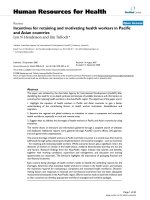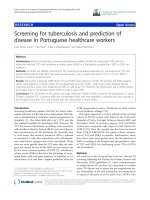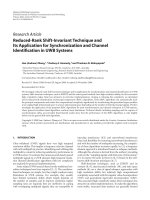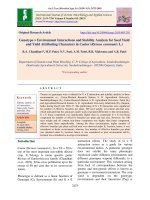Combining ability for yield and yield attributes characters in Greengram (Vigna radiata L. Wilczek) - Trường Đại học Công nghiệp Thực phẩm Tp. Hồ Chí Minh
Bạn đang xem bản rút gọn của tài liệu. Xem và tải ngay bản đầy đủ của tài liệu tại đây (415.05 KB, 7 trang )
<span class='text_page_counter'>(1)</span><div class='page_container' data-page=1>
<i><b>Int.J.Curr.Microbiol.App.Sci </b></i><b>(2017)</b><i><b> 6</b></i><b>(11): 3552-3558 </b>
3552
<b>Original Research Article </b>
<b>Combining Ability for Yield and Yield Attributes Characters in </b>
<b>Greengram (</b>
<i><b>Vigna radiata</b></i>
<b> L. Wilczek) </b>
<b>S.M. Surashe*, D.K. Patil and V.K. Gite </b>
Agricultural Research Station Badnapur, Vasantrao Naik Marathwada, Krishi Vidyapeeth,
Parbhani- 431 402, Maharashtra, India
<i>*Corresponding author </i>
<i><b> </b></i> <i><b> A B S T R A C T </b></i>
<i><b> </b></i>
<b>Introduction </b>
Greengram [<i>Vigna radiata</i> (L.) <i>Wilczek</i>], is an
economically important short duration grain
legume characterized by relatively more
palatable, nutritive, cheap source of high
quality and easily digestible protein,
non-flatulent than other pulses and constitute an
important source of cereal based diets in Asia
(Kamleshwar <i>et al.,</i> 2014). In-spite of high
demand, the yield of greengram worldwide is
very low (384 kg/ha) and limited success has
been achieved so far in augmenting its yield.
To enhance the present yield levels, it is
essential a systemic varietal improvement
through hybridization and exploitation of
generated variability through recombination
breeding. To breed a genotype with high
yielding potential, the information on the
genetic mechanism controlling various traits
in the material being handled, is a
pre-requisite. The estimates of combining ability
along with per se performance of genotypes in
a crop improvement program have a direct
bearing upon the choice of breeding
methodology to be followed and to identify
the parent and crosses (Khattak <i>et al.,</i> 2004),
which could be exploited for future breeding
programme. In literature, both additive and
non-additive genetic systems, controlling seed
yield and yield-relating traits in greengram,
have been reported (Barad <i>et al.,</i> 2008,
<i>International Journal of Current Microbiology and Applied Sciences </i>
<i><b>ISSN: 2319-7706</b></i><b> Volume 6 Number 11 (2017) pp. 3552-3558 </b>
Journal homepage:
Five lines were crossed with four testers in Line × Tester fashion to estimate the
combining ability for yield and yield attributing traits in greengram. Analysis of variance
revealed significant differences among genotypes, crosses, lines, testers and line × tester
interactions for most of the traits. Preponderance of non-additive gene effects was realized
from higher values of specific combining ability compared to general combining ability
and ratio of variances of SCA to GCA except for day to maturity. Parents’ viz., IPM 2-3,
ML 1299, ML and 2037 were considered as superior parents as they recorded high per se
performance with positive significant effects for seed yield per plant and other yield
contributing traits. Cross combinations viz., BM 2003-2 x IPM 2-3, VAIBHAV x IPM
409-4, BM 4 x MH 15, BM 4 x PUSA 0612, VAIBHAV x ML 1299, AKM 4 x MH
2-15, BM 2002-1 x ML 818 and AKM 4 x IPM 409-4 were found to be good specific
combinations for seed yield per plant and other desirable traits. These cross combinations
could be utilized for further amelioration of seed yield in greengram.
<b>K e y w o r d s </b>
SCA, GCA and
Greengram.
<i><b>Accepted: </b></i>
26 September 2017
</div>
<span class='text_page_counter'>(2)</span><div class='page_container' data-page=2>
<i><b>Int.J.Curr.Microbiol.App.Sci </b></i><b>(2017)</b><i><b> 6</b></i><b>(11): 3552-3558 </b>
3553
Marappa, 2008; Sathya and Jayamani, 2011;
Sujatha and Kajjidoni, 2013 and Suresh,
2014). However, the major part of genetic
variation for yield and its components was
conditioned due to higher magnitude of
non-additive genetic effects (Marappa, 2008;
Sathya and Jayamani, 2011; Sujatha and
Kajjidoni, 2013 and Suresh, 2014). Seed yield
and several yield contributing characters lack
stability due to strong environmental
influence, suggesting the need for breeding
for specific environment. Therefore, the
present investigation was planned and
executed to assess the nature of gene action
involved and combining ability of parental
genotypes for different characters utilizing
Line × Tester mating design (Kempthorne,
1957) for evolving productive varieties in
greengram.
<b>Materials and Methods </b>
Five lines BM 4, BM 2002-1, BM 2003-2,
AKM 4, and VAIBHAV were crossed with
seven tester IPM 409-4, ML 1299, MH 2-15,
IPM 2-3, ML 2037, ML 818, and PUSA 0612
in Line X tester fashion at Agricultural
Research station, Badnapur. College of
Agriculture Badnapur, Maharastra. All the
genotypes (twelve parent and 35 F1, s) were
evaluated in Randomized Block Design with
two replication during summer, 2014. Each
genotype was grown in one row of four meter
length with a spacing of 30cm between row
and 15cm between plants. Recommended
agronomic and plant protection package of
practice were followed to raise healthy crop.
Data were recorded on five randomly selected
competitive plants in each genotype and
replication. Mean value on per plant basis
were recorded for the characters, <i>viz.,</i> plant
height, number of cluster per plant, number of
pod per cluster, number of pod per plant,
number of seed per pod, pod length, hundred
seed weight, seed yield per plant, protein
content and the micro-Kjeldahl ‘N’ procedure
was used for the determination of nitrogen
and crude protein was estimated by
multiplying the nitrogen content by a factor of
6.25. However, data on day to 50% flowering
and maturity were recorded on plot basis. The
mean data was analysed to compute
combining ability effect and their variances
according to Kempthorne (1957).
<b>Results and Discussion </b>
Analysis of variance along with the estimates
of gca and sca variance their ratio for eleven
character is shown in table 1. The annova
showed highly significant differences for
majority of character, indicating the presence
of sufficient variability in experimental
material. The variance due to crosses was
highly significant for all the traits which
indicated the diverse nature of selected parent
for majority of the character. Partitioning of
variance among the hybrid revealed that the
mean square due to line showed highly
significant differences for plant height, pod
length and 100 seed weight, which indicated
the presence of sufficient variability for these
three characters. Significant variance is due to
tester for plant height and protein content.
The significant variance due to line x tester
interaction for all the traits excepting that of
plant height showed its existence among the
tester and hybrid population respectively for
these eleven traits. This indicated the presence
of significant differences between males and
females.
</div>
<span class='text_page_counter'>(3)</span><div class='page_container' data-page=3>
<i><b>Int.J.Curr.Microbiol.App.Sci </b></i><b>(2017)</b><i><b> 6</b></i><b>(11): 3552-3558 </b>
3554
number of clusters per plant, pod length and
hundred seed weight, while VAIBHAV was
good general combiner for plant height,
number of pod per plant and protein per cent.
Out of seven males, IPM 409-4 was a good
general combiner for number of pod per
cluster, number of pods per plant, where as
ML 1299 was found good general combiner
for Days to maturity, number of pod per plant
and seed yield per plant. The tester MH 2-15
was found good general combiner for day to
50% flowering, days to maturity and number
of pod per cluster.
Whereas IPM 2-3 was a good general
combiner for day to 50% flowering, day to
maturity, number of cluster per plant, number
of pod per cluster, number of pod per plant,
pod length, seed yield per plant and protein
per cent, whereas ML 2037 was a good
general combiner for day to 50% flowering,
day to maturity, number of cluster per plant,
pod length, hundred seed weight and protein
per cent, whereas ML 818 also good general
combiner for day to maturity and hundred
seed weight, whereas PUSA 0612 was a good
general combiner for plant height, and protein
per cent (Table 2). Similar results were
reported by Reddy and Sreeramulu (1982),
Choudhary (1986), Halkunde <i>et al.,</i> (1996),
Dasgupta <i>et al.,</i> (1998), Jahagirdar (2001),
Aher <i>et al.,</i> (1999), Singh (2005), Barad <i>et al.,</i>
(2008), Patil <i>et al.,</i> (2011).
The cross combination BM 2003-2 X IPM 2-3
(5.63) recorded highest significant desirable
SCA effect for grain yield per plant. Similar
result has also been reported by Barad <i>et al.,</i>
(2008), Patil <i>et al.,</i> (2011).
The cross combination BM 4 x PUSA 0612
(7.42) recorded highest significant desirable
SCA effect for number of pods per plant. This
result is in agreement with the finding of
Ahuja (1980), Shanthi priya <i>et al.,</i> (2012).
The highest significant negative desirable
SCA effect was observed for days to 50%
flowering in AKM 4 x ML 2037 (-3.30) these
finding are in agreement with earlier report
made by Deshmukh and Manjare (1980) and
Jahagirdar (2001)<b>. </b>
The highest significant negative desirable
SCA effect was observed for days to maturity
in BM 2003-2 x ML 2037 (-2.91) similar
result were also reported by Jahagirdar
(2001).
For plant height in BM 2003-2 x ML 2037
(5.84) was observed highest significant
desirable SCA effect. This result was in
agreement with the findings of Manjare
(1976), Shanthi priya <i>et al.,</i> (2012)
The cross combination BM 2002-1 x IPM
409-4 (2.91) had recorded highest significant
desirable SCA effect for number of clusters
per plant. Similar results were also reported
by Manjare (1976), Shanthi priya <i>et al.,</i>
(2012).
For number of pods per cluster in BM 4 x MH
2-15 (1.94) was revealed highest significant
desirable SCA effect. This result was in
agreement with the finding of Shanthi priya <i>et </i>
<i>al.,</i> (2012).
The cross combination AKM 4 x ML 1299
(1.53) observed highest significant desirable
SCA effect for number of seed per pod (Table
3). These results are in confirmation with the
previous work done by Jahagirdar (2001), and
Singh and Dikshit (2003).
The hybrid combination BM 2003-2 x IPM
409-4 (1.83) recorded highest significant
desirable SCA effect for pod length.
</div>
<span class='text_page_counter'>(4)</span><div class='page_container' data-page=4>
<i><b>Int.J.Curr.Microbiol.App.Sci </b></i><b>(2017)</b><i><b> 6</b></i><b>(11): 3552-3558 </b>
3555
<b>Table.1 </b>Analysis of variance of line X tester with respect to eleven characters in Mungbean [<i>Vigna radiata</i> (L.) Wilczek]
<b>Sorce of variability </b> <b>d.f </b>
<b>Days to </b>
<b>50% </b>
<b>flowering </b>
<b>Days to </b>
<b>maturity </b>
<b>Plant </b>
<b>height </b>
<b>No. of </b>
<b>clusters </b>
<b>per plant </b>
<b>No. of </b>
<b>pods per </b>
<b>cluster </b>
<b>No. of </b>
<b>pods per </b>
<b>plant </b>
<b>No. of </b>
<b>seeds </b>
<b>per pod </b>
<b>Pod </b>
<b>length </b>
<b>100- seed </b>
<b>weight </b>
<b>yield per </b>
<b>plant </b> <b>Protein </b>
<b>Replication </b> 1 0.51 0.01 1.06 0.58 0.25 1.82 0.02 0.04 0.02 0.82 0.01
<b>Crosses </b> 34 8.15** 34.41** 56.78** 5.67** 2.54** 47.10** 1.46** 3.41** 0.79** 9.64** 2.86**
<b>Lines </b> 4 11.66 28.76 121.47* 6.47 5.09 95.94 1.91 13.18** 3.88** 12.54 4.36
<b>Testers </b> 6 15.49* 133.43** 120.41** 3.29 0.75 53.57 1.63 1.65 0.46 5.95 5.62*
<b>Females x Males (L x T) </b> 24 5.73** 10.60** 30.08 6.14** 2.48** 37.35** 1.34** 2.22** 0.35** 10.08** 1.92**
<b>Error </b> 34 0.86 0.44 2.60 0.16 0.07 0.49 0.22 0.02 0.02 0.96 0.09
* and ** indicates significance at 5 and 1 per cent level respectively
<b>Table.2 </b>Estimation of general combining ability with respect to eleven characters in Mungbean (<i>Vigna radiata </i>L<i>. Wilczek</i>)
<b>Genotypes </b>
<b>Days to </b>
<b>50% </b>
<b>flowering </b>
<b>Days to </b>
<b>maturity </b>
<b>Plant </b>
<b>height </b>
<b>No. of </b>
<b>clusters </b>
<b>per plant </b>
<b>No. of </b>
<b>pods per </b>
<b>cluster </b>
<b>No. of </b>
<b>pods per </b>
<b>plant </b>
<b>No. of </b>
<b>seeds per </b>
<b>pod </b>
<b>Pod length </b> <b>100 seed </b>
<b>weight </b>
<b>Seed yield </b>
<b>per plant </b>
<b>Protein </b>
<b>per cent </b>
<b>Testers </b>
IPM 409-4 2.44** 7.80** 0.86 -0.07 0.21* 1.56** -0.89** 0.03 -0.14* -0.16 -0.42**
ML 1299 0.44 -2.60** -1.34* -0.12 -0.01 3.15** 0.17 -0.27** -0.12* 0.60* -0.03
MH 2-15 -1.25** -0.50* -2.66** -0.91** 0.29** 0.43 0.26 -0.16** 0.00 0.36 -1.17**
IPM 2-3 -0.65* -2.80** -2.02** 0.43** 0.25** 1.55** -0.03 0.38** 0.04 0.90** 0.50**
ML 2037 -1.05** -0.80** -0.83 0.95** -0.19* -1.71** 0.20 0.64** 0.20** -0.22 1.10**
ML 818 0.04 -1.80** -1.43** -0.16 0.07 -1.52** 0.13 -0.06 0.33** -0.01 -0.40**
PUSA 0612 0.04 0.70** 7.46** -0.12 -0.63** -3.44** 0.14 -0.56** -0.29** -1.47** 0.43**
<b>S.E ± </b> 0.28 0.20 0.51 0.11 0.08 0.21 0.15 0.05 0.05 0.29 0.08
<b>C.D. at 5% </b> 0.57 0.41 1.04 0.23 0.17 0.43 0.31 0.11 0.12 0.59 0.17
<b>C.D. at 1% </b> 0.76 0.55 1.39 0.31 0.23 0.58 0.42 0.15 0.16 0.80 0.22
<b>Lines </b>
BM 4 1.47** 2.08** 3.22** -0.85** 0.83** 1.82** -0.01 -0.59** -0.43** 0.06 -0.30**
BM 2002-1 -0.10 -1.84** -3.43** -0.02 -0.52** -3.19** 0.61** 1.13** 0.44** -1.18** -0.32**
BM 2003-2 -0.88** -0.48** -1.68** 1.03** -0.563** -2.14** -0.13 0.82** 0.59** 0.26 -0.41**
AKM 4 -0.60* 0.44* -1.03* 0.04 0.39** 3.00** -0.39** -1.18** -0.61** 1.36** 0.11
VAIBHAV 0.11 -0.20 2.93** -0.20* -0.13 0.51** -0.07 -0.17** 0.00 -0.51* 0.92**
<b>S.E ± </b> 0.23 0.17 0.43 0.09 0.07 0.18 0.13 0.04 0.05 0.24 0.07
<b>C.D. at 5% </b> 0.48 0.34 0.88 0.20 0.14 0.37 0.26 0.09 0.10 0.50 0.14
<b>C.D. at 1% </b> 0.64 0.46 1.18 0.26 0.1985 0.4981 0.35 0.13 0.13 0.67 0.19
</div>
<span class='text_page_counter'>(5)</span><div class='page_container' data-page=5>
<i><b>Int.J.Curr.Microbiol.App.Sci </b></i><b>(2017)</b><i><b> 6</b></i><b>(11): 3552-3558 </b>
3556
<b>Table.3 </b>Estimates of specific combining ability with respect to 11 characters in Mungbean (<i>Vigna radiata L. Wilczek</i>)
<b>Sr. </b>
<b>No. </b> <b>Crosses </b>
<b>Days to 50% </b>
<b>flowering </b>
<b>Days to </b>
<b>maturity </b>
<b>Plant </b>
<b>height </b>
<b>Cluster/ </b>
<b>plant </b>
<b>No. of pods/ </b>
<b>cluster </b>
<b>No. of pods/ </b>
<b>plant </b>
<b>No. of </b>
<b>seed/ pod </b> <b>Pod length </b>
<b>100 seed </b>
<b>weight </b> <b>Yield/plant </b> <b>Protein </b>
1 BM 4 X IPM 409-4 1.12 -2.08** 0.78 -1.45 ** -2.03** -7.08** 1.02** -1.49** -0.02 -2.77** 0.29
2 BM 4 X ML 1299 -0.37 0.31 -2.00 0.69* -0.85** -3.12** -0.34 0.26* 0.02 -1.90** -1.29 **
3 BM 4 X MH 2-15 0.82 -1.28** 2.91* 0.43 1.94** 6.69** -0.43 0.00 -0.18 2.50** -0.10
4 BM 4 X IPM 2-3 -0.77 2.01** 2.47* -0.05 -0.02 2.02** -0.03 1.65** -0.02 0.69 -0.68**
5 BM 4 X ML 2037 0.12 4.51** 1.18 -0.72** 1.93** -1.35** -0.27 -0.59** -0.05 -0.20 -0.58**
6 BM 4 X ML 818 -0.47 -0.98* 0.53 -1.26** -0.64** -4.59** 0.09 -0.24 0.16 -0.54 1.37**
7 BM 4 X PUSA 0612 -0.47 -2.48** -5.91** 2.34** -0.33 7.42** -0.01 0.40** 0.10 2.23** 0.99**
8 BM 2002-1 X IPM 409-4 2.70** 2.84** 1.44 2.91** -0.57** -1.31* 1.35** 0.92** -0.20 -1.43* -0.98**
9 BM 2002-1 X ML 1299 0.20 0.74 -1.74 -2.03** 0.70** 0.79 -1.07** -0.84** 0.32* 0.08 0.78**
10 BM 2002-1 X MH 2-15 -1.10 -0.85 -0.67 0.35 -1.10** -6.23** -0.56 0.72** -0.01 -0.62 -1.12**
11 BM 2002-1 X IPM 2-3 -1.20 0.94* 0.63 -1.93** -0.66* -2.30** 0.29 -0.57** 0.06 -0.45 1.42**
12 BM 2002-1 XML 2037 0.70 -1.05* -1.05 0.793** -0.81** 0.71 0.55 0.65** 0.44** 0.77 -0.56**
13 BM 2002-1 X ML 818 0.10 -0.05 2.59* -0.39 1.81 5.92** -0.03 -1.12** -0.26 1.91** 0.19
14 BM 2002xPUSA0612 -1.40* -2.55** -1.20 0.31 0.62** 2.39** -0.54 0.24 -0.35* -0.26 0.26
15 BM 2003-2 XIPM 409-4 -2.51** 0.48 -2.75* -1.84** 1.46** 2.43** -0.90* 1.83** 0.15 -0.30 0.89**
16 BM 2003-2 X ML 1299 -0.01 -1.11* -5.79** -0.69* -0.15 0.94 -0.52 -0.51** -0.01 -0.99 -0.21
17 BM 2003-2 X MH 2-15 -2.81** 5.28** 1.07 -2.70** -1.31** -3.03** 0.53 -1.37** -0.15 -3.09** 0.65**
18 BM 2003-2 X IPM 2-3 2.08** -1.91** -0.91 1.95** 1.52** 6.24** 0.98** -0.86** 0.45** 5.63** -0.52**
19 BM 2003-2 X ML 2037 0.98 -2.91** 5.84** 2.83** -1.02** -2.33** -0.18 1.11** 0.35* -0.98 0.62**
20 BM 2003-2 X ML 818 1.38* -0.91 0.44 1.29** -0.29 -0.12 0.21 1.42** 0.33* 1.45* -0.70**
21 BM 2003-2 X PUSA0612 0.88 1.08* 2.09 -0.84** -0.18 -4.10** -0.09 -1.62** -1.13** -1.70* -0.72**
22 AKM 4 X IPM 409-4 0.70 -1.94** -1.98 0.50 0.75** 2.33** -1.85** -1.35** -0.07 1.82** 1.13**
23 AKM 4 X ML 1299 1.70* 0.45 5.05** -0.05 0.53** -1.05* 1.53** 1.00** -0.15 0.74 0.50*
24 AKM 4 X MH 2-15 1.40* -1.64** -6.32** 1.98** 0.02 4.51** 0.34 0.06 -0.03 1.96** -1.26**
25 AKM 4 XIPM 2-3 -0.20 0.65 0.33 1.29** -0.93** -2.70** 0.06 0.09 -0.10 -3.33** -0.144
26 AKM 4 X ML 2037 -3.30** -1.34** 1.74 -0.87** 0.11 1.36** 0.30 -0.35** -0.08 0.76 0.387*
27 AKM 4 X ML 818 0.10 0.65 -3.45** -0.31 -0.25 0.07 -0.43 0.16 -0.06 -1.58* -0.09
28 AKM 4 X PUSA 0612 -0.40 3.15** 4.64** -1.50** -0.24 -4.55** 0.16 0.38** 0.44** -0.37 -0.52**
29 VAIBHAV X IPM 409-4 -2.01** 0.70 2.520* 0.89** 0.38 3.62** 0.38 0.09 0.15 2.69** -1.33**
30 VAIBHAV X ML 1299 -1.51* -0.40 4.48** 2.09** -0.23 2.43** 0.41 0.09 -0.18 2.06** 0.21
31 VAIBHAV X MH 2-15 1.68* -1.50** 3.005* -0.06 0.45* -1.94** 0.12 0.57** 0.31* -0.75 1.83**
32 VAIBHAV X IPM 2-3 0.08 -1.70** -2.53* -1.25** 0.09 -3.26** -1.17** -0.31* -0.39** -2.54** -0.06
33 VAIBHAV XML 2037 1.48* 0.80 -7.72** -2.02** -0.20 1.60** -0.40 -0.82** -0.65** -0.35 0.13
34 VAIBHAV X ML 818 -1.11 1.30** -0.12 0.68* -0.62** -1.28* 0.15 -0.21 -0.17 -1.22 -0.77**
35 VAIBHAV X PUSA 0612 1.38* 0.80 0.37 -0.30 0.13 -1.16* 0.49 0.59** 0.93** 0.11 -0.01
SE (+) 0.62 0.45 1.14 0.26 0.19 0.48 0.34 0.12 0.13 0.62 0.18
CD 5 % 1.27 0.91 2.33 0.53 0.39 0.98 0.70 0.26 0.26 1.33 0.38
</div>
<span class='text_page_counter'>(6)</span><div class='page_container' data-page=6>
<i><b>Int.J.Curr.Microbiol.App.Sci </b></i><b>(2017)</b><i><b> 6</b></i><b>(11): 3552-3558 </b>
3557
The cross combination VAIBHAV x PUSA
0612 (0.93) recorded highest significant
desirable SCA effect for hundred seed weight.
Similar result has also been reported by
Katiyar (2015) and Tiwari and Ramanujan
(1974).
In case of protein per cent the cross
combination VAIBHAV X MH 2-15 (1.83)
observed highest significant desirable SCA
effect. These results are with confirmation
with the result of Shanthi priya <i>et al.,</i> (2012).
The parents showed high GCA can be used
for the future hybridization programmes. The
gca estimates of lines and testers emphasized
the importance of lines AKM 4 and tester
IPM 2-3, ML 1299 for their use as a desirable
parents for enhancing the yield potential
through assembling the favourable genes for
yield and yield components.
The crosses which showed high SCA effect
could be used for the hybrid development.
The high yielding crosses <i>viz</i>., BM 2003-2 X
IPM 2-3, VAIBHAV X IPM 409-4, BM 4 X
MH 2-15 were found to be the superior for
seed yield and yield component and should be
further tested across the different environment
for their stability performance.
AKM 4 was best combiner for seed yield per
plant and other some character like number of
pod per cluster, number of pod per plant and
negative significant for days to 50%
flowering; ML 1299 for days to maturity,
number of pod per plant, seed yield per plant
and IPM 2-3 for days to 50% flowering, days
to maturity, number of cluster per plant,
number of pod per cluster, number of pod per
plant, pod length, seed yield per plant and
protein content. Since high gca effect are due
to additive and additive x additive gene action
they can be readily exploited in breeding
program (Griffing, 1956).
<b>References </b>
Aher, R. P., Datur D. V. and Sonawane, Y. P.,
1999. Combining ability in mungbean.
Crop Res., 18:256-260.
Ahuja, S. L. 1980. Diallel analysis in F2
generation of mungbean, Thesis
Abstract (NAU- Hissar). 6(2): 110-111.
Barad, H. R., Pithia, M. S. and Vachhani, J.
H. 2008. Heterosis and combining
ability studies for economic traits in
mungbean (<i>Vigna radiate </i>(L.)Wilczek).
<i>Legume Res., </i>31.
Choudhary, R. K. 1986. Combining ability for
seed yield and its component in
mungbean. <i>Crop.Improv., </i>13(1):95-97.
Dasgupta T., Banik, A. and Das, S. 1998.
Combining ability in mungbean. <i>Indian </i>
<i>J. Pulses Res., </i>11(1): 28-32.
Deshmukh, R. B., Manjare, M. R. 1980.
Combining ability in mungbean.
<i>Legume Res</i>., 3(2): 97-101.
Griffing, B. 1956. Concept of general and
specific combining ability in relation to
diallel crossing system. Australian J.
Biol. Sci, 9:484-493.
Halakunde, I. S., Aher, R. P., Deshmukh, R.
B. and Kute, N. S. 1996.Combining
ability analysis in greengram. <i>J. </i>
<i>Maharashtra Agric.Univ.,</i>21(2): 235-
238..
Jahagirdar, J. E. 2001. Heterosis and
combining ability studies for seed yield
and yield components in mungbean.
<i>Indian j. pulses Res., </i>14(2): 141-142.
Katiyar, M and Amit Kumar. 2015. Genetics
Analysis of yield and its component
Traits in Mungbean (<i>Vigna radiata</i> L.
<i>Wilczek</i>). Internat. J. of Innovative Res.
And Development 4 (2): 119-121.
Kempthorne, O. 1957. An introduction to
genetical statistics. John Wiley and
Sons, New York.
</div>
<span class='text_page_counter'>(7)</span><div class='page_container' data-page=7>
<i><b>Int.J.Curr.Microbiol.App.Sci </b></i><b>(2017)</b><i><b> 6</b></i><b>(11): 3552-3558 </b>
3558
Agronomic traits. Korean J. Crop Sci.,
46(5): 420-423.
Manjare, M. R. 1976. Studies on heterosis and
combining ability in 8 × 8 diallel cross
of mungbean. M. Sc. (Agri.). Thesis
Mahatma Phule Krishi Vidyapeeth,
Rahuri.
Panse, V.G. and Sukhatme, P. V. 1967.
Statistical methods for agricultural
work. Indian council of <i>Agric. Res</i>.,
New Delhi, pp. 167-174.
Sathya, M. and Jayamani, P. 2011. Heterosis
and combining ability studies in
greengram. <i>J. of Food Legumes </i>24(4):
282-287.
Shanthi Priya, M., Reddy, K H. P Reddy D.
M., and Rupesh Kumar Reddy., 2012.
Combining ability studies in greengram.
(<i>Vigna radiate </i>(L.) Wilczek). <i>Legume </i>
<i>Res</i>., 31(1): 36-39.
Singh M., 2005. Study of combining ability
for physiological traits in urdbean
(<i>Vignamungo</i> (L.) Hepper). <i>Legume </i>
<i>Res., </i>28(2):107-110.
Singh, B. B. and Dikshit, H. K. 2003.
Combining ability studies for yield and
architectural traits in mungbean. (<i>Vigna </i>
<i>radiata</i> (L.) Wilczek) <i>Indian J. Genet.</i>,
63(4): 351-352.
Sprague, G. F. and Tatum L. A. 1942.
General verses specific combining
ability in single crosses of corn. <i>J. </i>
<i>Amer. Soc. Agron.,</i>34: 923-932.
Suresh, S., Jebaraj, S., Juliet Hepziba, S. and
Theradimani, M. 2010. Genetic studies
in mungbean (<i>Vigna radiata</i> (L.)
<i>Wilczek</i>) Electronic <i>J</i>. of Plant breeding,
1 (6): 1480-1482.
Tiwari, A. S. and Ramanujan, S. 1974. Partial
diallel analysis of combining ability in
mungbean.Z. Pflazucht, 73(1): 103-111.
Yadav, P. S. and Lavanya, G. R. 2011.
Estimation of combining ability effect
in mungbean (<i>Vigna radiata</i> (L.)
<i>Wilczek)</i> crosses. Madras <i>Agric.</i> <i>J</i>. 98
(7-9): 213-215.
<b>How to cite this article: </b>
</div>
<!--links-->
MUTAGENIC INDUCTION OF AGRONOMICAL AND YIELD CONTRIBUTING TRAITS IN SOYBEAN (GLYCINE MAX (L.) MERRILL) WITH GAMMA IRRADIATION
- 10
- 626
- 0






![Effect of fertility levels and stress mitigating chemicals on nutrient uptake, yield and quality of mungbean [Vigna radiata (L.) Wilczek] under loamy sand soil of Rajasthan](https://media.store123doc.com/images/document/2020_01/09/medium_ftp1578562755.jpg)
![Generation mean analysis for yield, yield components and MYMV disease scores in blackgram [Vigna mungo (L).Hepper]](https://media.store123doc.com/images/document/2020_01/09/medium_kiu1578565010.jpg)
